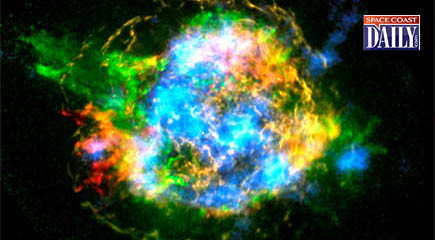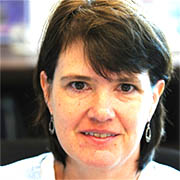NASA’s NuSTAR Untangles Mystery of How Stars Explode
By Space Coast Daily // June 4, 2014
ABOVE VIDEO: NuSTAR is showing that exploding stars slosh around before blasting apart.This 3-D computer simulation demonstrates how the supernova explosion might look.
Nustar First Telescope Capable Of Producing Maps Of Radioactive Elements In Supernova Remnants
NASA.gov — One of the biggest mysteries in astronomy, how stars blow up in supernova explosions, finally is being unraveled with the help of NASA’s Nuclear Spectroscopic Telescope Array (NuSTAR).

The high-energy X-ray observatory has created the first map of radioactive material in a supernova remnant. The results, from a remnant named Cassiopeia A (Cas A), reveal how shock waves likely rip apart massive dying stars.
“Stars are spherical balls of gas, and so you might think that when they end their lives and explode, that explosion would look like a uniform ball expanding out with great power,” said Fiona Harrison, the principal investigator of NuSTAR at the California Institute of Technology (Caltech) in Pasadena. “Our new results show how the explosion’s heart, or engine, is distorted, possibly because the inner regions literally slosh around before detonating.”

Harrison is a co-author of a paper about the results appearing in the Feb. 20 issue of Nature.
Cas A was created when a massive star blew up as a supernova, leaving a dense stellar corpse and its ejected remains. The light from the explosion reached Earth a few hundred years ago, so we are seeing the stellar remnant when it was fresh and young.

Supernovas seed the universe with many elements, including the gold in jewelry, the calcium in bones and the iron in blood. While small stars like our sun die less violent deaths, stars at least eight times as massive as our sun blow up in supernova explosions.
The high temperatures and particles created in the blast fuse light elements together to create heavier elements.
NuSTAR is the first telescope capable of producing maps of radioactive elements in supernova remnants. In this case, the element is titanium-44, which has an unstable nucleus produced at the heart of the exploding star.

The NuSTAR map of Cas A shows the titanium concentrated in clumps at the remnant’s center and points to a possible solution to the mystery of how the star met its demise. When researchers simulate supernova blasts with computers, as a massive star dies and collapses, the main shock wave often stalls out and the star fails to shatter.
The latest findings strongly suggest the exploding star literally sloshed around, re-energizing the stalled shock wave and allowing the star to finally blast off its outer layers.
“With NuSTAR we have a new forensic tool to investigate the explosion,” said the paper’s lead author, Brian Grefenstette of Caltech.

“With NuSTAR we have a new forensic tool to investigate the explosion,” said the paper’s lead author, Brian Grefenstette of Caltech.
“Previously, it was hard to interpret what was going on in Cas A because the material that we could see only glows in X-rays when it’s heated up. Now that we can see the radioactive material, which glows in X-rays no matter what, we are getting a more complete picture of what was going on at the core of the explosion.”

The NuSTAR map also casts doubt on other models of supernova explosions, in which the star is rapidly rotating just before it dies and launches narrow streams of gas that drive the stellar blast.
Though imprints of jets have been seen before around Cas A, it was not known if they were triggering the explosion. NuSTAR did not see the titanium, essentially the radioactive ash from the explosion, in narrow regions matching the jets, so the jets were not the explosive trigger.
“This is why we built NuSTAR,” said Paul Hertz, director of NASA’s astrophysics division in Washington. “To discover things we never knew – and did not expect – about the high-energy universe.”
The researchers will continue to investigate the case of Cas A’s dramatic explosion. Centuries after its death marked our skies, this supernova remnant continues to perplex.












